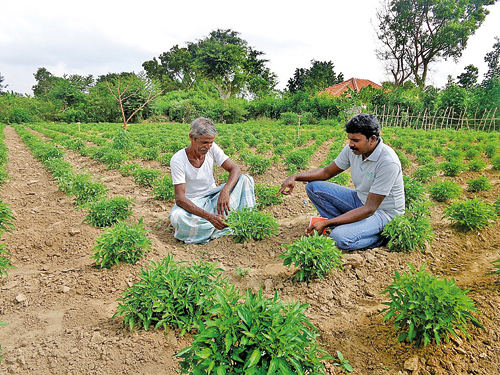NGOs, finance companies and money lenders

File picture of a farmer among those who require micro finance.
Till around the mid-1980s Sri Lanka’s poor was mainly dependent on money lenders for credit. Then came formal microfinance started by NGOs following the example set by Grameen and others in the 70s. The market share of NGOs microfinance grew with a large fund from JTF/NDTF, a fund for on-lending to micro finance provided by ADB/WB. The Government also started micro finance at affordable interest with few programmes mainly Samurdhi and RDB.
By the end of the 1990s NGO and government-led micro finance grew and money lenders’ share of the market declined sharply. Finance companies and profit-driven private companies smelled profits in micro finance and started investing in micro finance to make profits. There was still an adequate market for them as NGOs/government did not have sufficient capital by then due to JFT/NDTF being closed for reasons given later.
In the government’s case, it did not provide adequate capital to fill the needs of all the poor in a nation where 40 per cent of the population does not have an income of more than Rs.1500 a day. But finance companies charged exorbitant interest rates, nearly three times that of most NGOs. But for the poor this was still attractive as it was cheaper than money lenders. Finance companies or most of them were aggressive, and they pushed loans by even visiting homes and making it sound attractive. They also pushed for repayments harshly, even visiting homes again and even harassing women borrowers.
NGO practices
These were not practices the majority of NGOs used. Of course money lenders were far worse. However as money lenders are invisible and finance companies are formal, finance companies/private companies (private profit making) became a target of an attack for charging between 36 per cent to 60 per cent interest. Initial attacks came from the media and few activists, then the first government attack came from former Minister Pillayan (Sivanesathurai Chandrakanthan) and followed by Ms. P.S. Charles, then District Secretary of Batticaloa. This criticism grew nationally, culminating in a rule for maximum interest rates to be 25 per cent, declared by the last government. This was not a problem for good NGOs, but became a huge problem for most finance/private companies and they withdrew from offering small loans (eg starting from Rs.25,000) and moved to much larger minimum loan sizes (eg Rs. 250,000). Of course some still call these larger loans microfinance and this is not surprising as some even call loans of Rs.1 million to Rs.10 million as micro finance.
Meanwhile most NGOs have also reduced or stopped microfinance due to lack of capital as wholesaling or bulk sources like NDTF was closed and its capital transferred to a state savings bank which was ordered to on-lend to NGOs. They did support some but its rules were not that easy as that of NDTF which was not a bank but a development agency. Now even this bank was merged with a larger bank virtually ending this access.
Some major NGOs became finance/private companies as owners or controlling persons were inclined to do this for obvious reasons, particularly to overcome funding pressures and regulatory compliance. Among these NGOs were the first best microfinance practiced NGO in Sri Lanka started by Sarvodaya named SEEDS and SewaFinance, an offshoot of SewaLanka Foundation.
Small loans
All these actions by previous governments and the private sector have ensured that now there are so few formal sources for small loans such as Rs.25,000 for the poor. The poor is thrust back into the hands of money lenders. The dream the writer and many other like-minded people had of providing small loans to the poor at affordable interest rates has not materialized. This government has a responsibility to create a way to ensure that sustainable but yet affordable microfinance is available. But it should also reform the Samurdhi programme which depends on Treasury subsidized staff, which is not transparent with no indicators used or accounts shown.
It is indeed a pity that we still fail to provide policy and mechanisms to reduce the reach of money lenders by assisting formal approaches to providing microfinance as done in Bangladesh and India.
This government has for the first time appointed a State Minister in charge of microfinance showing its importance to the poor. He is a young educated person who wants results. Unfortunately the key government microfinance programmes such as Samurdhi and RDB programmes do not come under his supervision and this is an error which should be corrected. Recommendations to the Minister are:
1. Work with the Central Bank to find a new way of ensuring that the extreme poor have access to credit, examples are ordering banks to give a percentage of their portfolio for such loans at low interest rates and finding additional ways to deliver besides NGOs, examples are RDB, rural banks some of which also need reform.
2. Pushing government to reform Samurdhi microfinance and ensuring that it is transparent both in accounts and key indicators. Ensure that it does not give loans in a way that the government subsidises it.
3. Encourage and support credit plus work meaning training in business management, technology and soft skills like leadership to borrowers by all agencies active in microfinance.
(The writer is a Former
Chief Executive Berendina/
SEEDS and International Consultant.
He can be reached at dulande@gmail.com)



